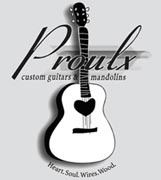|
Click
On Any Image To View Full Size
| |
|
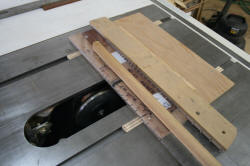
After ripping(slicing) the cocobolo fretboards from a billet(sorry, no
photos...), out comes my simple fret slotting jig, .022" kerf saw blade,
and fret spacing template.
|
|
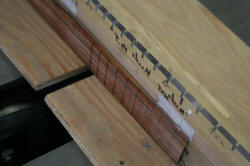
Here's what it looks like, after a few slots are cut. The template
indexes into a pin imbedded in the jig; the solid, tight fit between pin
and template insures accurate fret placement. |
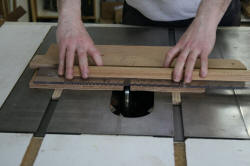
I have a "handle" attached to my template, which I use to hold
everything tight to the jig, and keep my fingers away from the saw
blade.
|
|
|
|
|
|
|
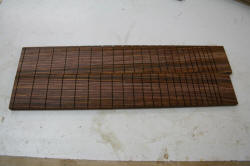
Here are our two slotted fretboards. Notice one is shorter? I've been
itching to try a shorter scale length, and decided this would be the
right mandolin to do so. The scale length of our A-52 will be 13-1/2",
versus my already slightly-shorter-than-standard 13-3/4" scale. In
mathematical terms, this is roughly like going from a Martin dreadnought
scale of 25.4" to Gibson's 24.6" scale length. I expect the string's
feel to be nice and light, and the tone to have a slightly quicker
decay(less sustain). We'll see! |
|
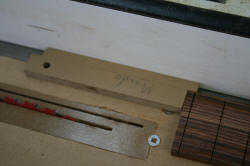
Need to taper these bad puppies, eh? Here's the cleanest, simplest, most
foolproof and accurate tapering "jig"! Just a wee little block to offset
the nut end a set amount, with its opposite end being exactly double in
width. |
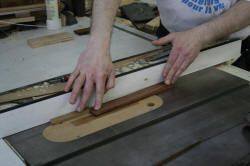
The fretboard is held to the little "jig", the saw's fence is set to the
widest width desired, and a cut is made. Next, flip the fretboard over,
and make another cut, using the double-width end of the "jig". Perfect
taper, every time.
Thanks to Sylvan Wells for showing me this! |
|
|
|
| |
|
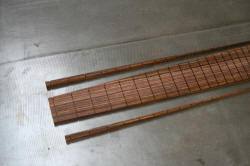
Proof that we have our "jig" correctly made is for the wedge shaped off
cuts to be identical, which these are. |
|
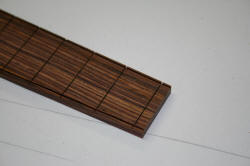
Next, I'll cut a slot, again using the .022" slotting blade, 1/16" inset
from the edge. |
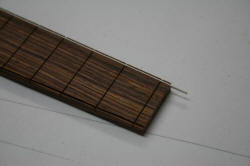
In this slot, I'll glue a .020" white fiber purfling; the glue will
swell the fiber slightly, proving a tight fit to the .022" slot. |
|
|
|
|
|
|
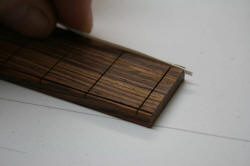 |
|
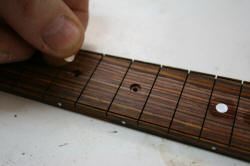
Side dots(position markers) are added, as well as mother of pearl dots
on the fretboard surface. |
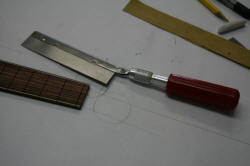
I'll use a razor saw to cut the purfling lines through the slots, for
fretting. |
|
|
|
| |
|
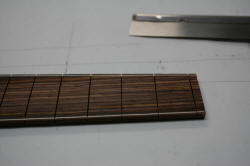 |
|
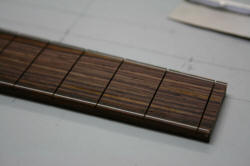
Notice something "different" here? Kudos to everyone who spotted the
zero fret setup! I've long been a strong opponent of zero frets, but
with the advent of stainless steel frets that are all but impossible to
wear, I've felt the time might be right to re-think this. So, here we
go; another first for me. More on this setup later, when we do the
actual setup; you'll be learning alongside of me! |
..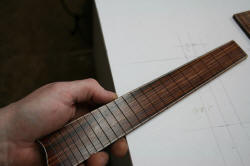
Sam's fretboard will be nude, without surface markers or dots. His also
has a compound radius of roughly 9" radius at the nut, whereas the SFSF
A-52 will be a flat fingerboard. |
|
|
|
|
|
|
|
|
|
|
|
|
|
| |
|
|
|
|
|
|
|
|
|
|
|
|
|
|
|
|
|
|
This A-52 model is being donated to the Studdard Family Scholarship Fund,
and it will be drawn on June 26th, 2009 at Steve Kaufman's Acoustic Kamp. If
you would like to purchase a chance(ticket), or to simply donate something
toward the fund, please contact Warren
Knorr or
call JoEllen at Steve's Flatpik
Central Ph 865 982 3808 Mon-Fri 9AM to 2PM EST Each $10(Ten Dollar) donation
buys one chance/ticket!
PREVIOUS PAGE
NEXT
PAGE
|
